Mil Mi-8
The Mil Mi-8 (Russian: Ми-8, NATO reporting name: Hip) is a medium twin-turbine helicopter, originally designed by the Soviet Union, and now produced by Russia. In addition to its most common role as a transport helicopter, the Mi-8 is also used as an airborne command post, armed gunship, and reconnaissance platform. Along with the related, more powerful Mil Mi-17, the Mi-8 is among the world's most-produced helicopters,[1] used by over 50 countries. As of 2015, when combined the two helicopters are the third most common operational military aircraft in the world.[2]
| Mi-8 | |
|---|---|
.jpg) | |
| Mi-8 of Baltic Airlines taking off at Peter and Paul Fortress in Saint Petersburg | |
| Role | Transport helicopter (also several armed versions) |
| National origin | Soviet Union and Russia |
| Manufacturer | Kazan Helicopter Plant Ulan-Ude Aviation Plant |
| Design group | Mil Moscow Helicopter Plant |
| First flight | 7 July 1961 |
| Introduction | 1967 |
| Status | In service |
| Primary users | Soviet Union (historical) ca. 80 other countries, see Operators below |
| Produced | 1961–present |
| Number built | >17,000 and production continues today; world's most-produced helicopter |
| Variants | Mil Mi-8T/Mi-17 |
| Developed into | Mil Mi-14 |
Design and development
Mikhail Mil originally approached the Soviet government with a proposal to design an all-new two-engined turbine helicopter after the success of the Mil Mi-4 and the emergence and effectiveness of turbines used in the Mil Mi-6; but the military argued against a new helicopter, as they were content with the current Mil Mi-4.[3] To counter this, Mikhail Mil proposed that the new helicopter was more of an update to new turbine engines rather than an entirely new helicopter; this persuaded the council of ministers to proceed with production. Due to the position of the engine, this enabled Mikhail Mil to justify redesigning the entire front half of the aircraft around the single engine (designed by Oleksandr Ivchenko at OKB-478 in Zaporizhzhia, Ukraine, originally for fixed wing aircraft as all other soviet turbines had been up to that point).
The prototype, which was named V-8, was designed in 1958[3] and based on the Mil Mi-4 with a larger cabin.[4] Powered by an AI-24 2,010 kW (2,700 shp) Soloviev turboshaft engine,[5] the single engined V-8 prototype had its maiden flight in June 1961[6][7] and was first shown on Soviet Aviation Day parade (Tushino Air Parade) in July 1961.[8]
During an official visit to the United States in September 1959, Nikita Khrushchev took a flight in the S-58 presidential helicopter for the first time and was reportedly extremely impressed.[9][10] On Khrushchev's return, he ordered the creation of a similar helicopter, which was to be ready for the return visit by the American president, to save face.[11] A luxury version of the Mi-4 was quickly created and Khrushchev took an inspection flight, during which Mikhail Mil proposed that his helicopter in development was more suitable. However, it would be necessary to have a second engine for reliability. This gave Mikhail Mil the power under the orders of Khrushchev to build the original two-engined helicopter, which for the first time in Soviet history would need purpose-built turbine engines, rather than those adapted from fixed wing aircraft (as in the Mil Mi-6 and the first prototype V-8) and an entirely new main rotor gear box that would be designed in-house for the first time. In May 1960, the order was given for Mikhail Mil to create his twin engine helicopter. The Sergei Isotov Design Bureau accepted the task of creating the engines.
The second prototype (still equipped with the one turbine engine as the Isotov engines were still under development) flew in September 1961.
Two months after the engines were completed by Isotov, the third prototype designated V-8A equipped with two 1,120 kW (1,500 shp) Isotov TV2 engines, made its first flight piloted by Nikolai Ilyushin on 2 August 1962, marking the first flight of any Soviet helicopter to fly with purpose built gas turbine engines.[4] The aircraft completed its factory based testing in February 1963.
The fourth prototype was designed as a VIP transport, with the rotor changed from four blades to five blades in 1963 to reduce vibration, the cockpit doors replaced by blister perspex slides and a sliding door added to the cabin.[4]
The fifth and final prototype was a mass production prototype for the passenger market. In November 1964, all joint testing had been completed and the soviet government began mass production. Production started in the Kazan Production Plant, with the first aircraft completed by the end of 1965.
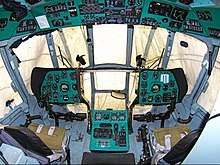
The Soviet military originally showed little interest in the Mi-8 until the Bell UH-1's involvement in the Vietnam war became widely publicised as a great asset to the United States, allowing troops to move swiftly in and out of a battlefield and throughout the country. It was only then that the Soviet military rushed a troop-carrying variant of the Mil Mi-8 into production. By 1967, it had been introduced into the Soviet Air Force as the Mi-8.
There are numerous variants, including the Mi-8T, which, in addition to carrying 24 troops, is armed with rockets and anti-tank guided missiles. The Mil Mi-17 export version is employed by around 20 countries; its equivalent in Russian service in the Mi-8M series. The only visible difference between the Mi-8 and Mi-17 is that the tail rotor is on the starboard side (right side) of the Mi-8, whereas in Mi-17 it is on the port side. Also Mi-17 also has some improved armour plating for its crew. The naval Mil Mi-14 version is also derived from the Mi-8. The Mi-8 is constantly improving and the newest version still remains in production in 2016.
Operational history
Finland
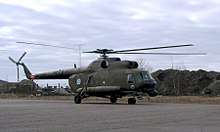
The Finnish Defence Forces and the Finnish Border Guard began using Mi-8s in the 1970s, with the Finnish Air Force receiving its first, serialed HS-2, on 28 May 1973, and the second, HS-1, on 31 May 1973. Six Mi-8Ts were obtained at first, followed by further two Mi-8Ts and two Mi-8Ps. Three of the helicopters were handed over to the Border Guard Wing. One of these was lost after sinking through ice during a landing in April 1982. It was soon replaced by a new Mi-8. After their Border Guard service, the helicopters were transferred to the civil register, but shortly thereafter to the Finnish Air Force. In 1997 it was decided that all helicopters, including the remaining five Mi-8Ts and two Mi-8Ps, should be transferred to the Army Wing at Utti. All Mi-8s have now been retired. One Mi-8 is on display at the Finnish Aviation Museum in Vantaa, and one is at the Päijänne Tavastia Aviation Museum in Asikkala, near Lahti. The two final Mi-8Ts were given to Hungary in August 2011 with all remaining spare parts.
Georgia
The Georgian air force started operating Mi-8 and Mi-17 helicopters from 1991 onwards. During the War in Abkhazia (1992–1993) Mi-8 helicopters were used by both sides. Several were shot down, the first one being a Georgian civilian Mi-8T which was destroyed in Soukhumi by an RPG-7. On 14 December 1992, a Russian Air Force Mi-8T was shot down by a SA-14 missile near Lata.[12] On another occasions Abkhaz Mi-8MTVs were shot down by Georgian forces, by SA-14 in one case and by RPG-18 in a second case, both during 1993.[12] In final case, Georgian Mi-8MTV carrying civilian refugees was shot down, killing 25 people.[12] Georgian Air Force and Police currently operate about 20 Mi-8T/MTVs.[13]
Iraq
Mi-8s were employed by the former Iraqi Army Aviation and Iraqi Air Force under Saddam Hussein. In the Iran–Iraq War of the 1980s, there were air-to-air combat between Iraqi and Iranian Army Aviation helicopters, including between Iranian Bell AH-1J Cobras and Iraqi Mi-8s.[14]
South Sudan
On 21 December 2012, a Nizhnevartovskavia owned Mi-8 working for the United Nations Mission in South Sudan (UNMISS) was shot down and crashed near Likuangole in the South Sudanese state of Jonglei during the South Sudan internal conflict. All four Russian crewmembers on board were killed, and after some initial confusion, a UN spokesman said that the South Sudanese army confirmed on 22 December that it mistakenly fired at the helicopter.[15][16]
On 26 August 2014, a UTair Aviation owned Mi-8 working for the United Nations crashed as it approached a landing airstrip near Bentiu. Three of the Russian crew members died and one was injured. Rebel commander Peter Gadet claimed that his forces brought it down using a rocket-propelled grenade.[17][18]
Soviet Union
The Mi-8 family of helicopters became the main Soviet and later Russian helicopter, covering a large range of roles in both peace time and war time. Large fleets of Mi-8 and its derivatives are employed by both military and civil operators.
Large numbers of Mi-8 family helicopters were used during the Soviet–Afghan War during the 1980s. Its rugged construction allowed easier in-theater operations and maintenance. A large number of Mi-8s were lost with several shot down by enemy fire, with the Mi-8 and its derivatives being the main aircraft model lost by the Soviet Union in Afghanistan.
Between April and May 1986, Mi-8s were used in large numbers to drop radiation-absorbing materials into the No. 4 reactor of Chernobyl Nuclear Power Plant after the Chernobyl disaster, and the fire was extinguished by the combined effort of helicopters dropping over 5000 metric tons of sand, lead, clay, and neutron-absorbing boron onto the burning reactor and injecting liquid nitrogen into it. Most of the helicopters were severely irradiated and abandoned in a giant junkyard,[19] the so-called "machines cemetery" near Chernobyl, with several disappearing from the site in later years. During the initial operation, one crashed near the power plant after hitting a construction crane cable with all the crew of four being killed in the crash.[20] It is now known that virtually none of the neutron absorbers reached the core.[21]
Ukraine
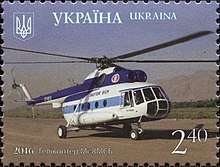
On 16 August 2013, the Ministry of Defense of Ukraine reported that one of its Mi-8s had set a world altitude record of 9,150 meters at the Kirovske military airfield on 15 August.[22]
The Ukrainian Armed Forces used Mi-8s along with Mi-24s in operations against rebels in Eastern Ukraine during the 2014 pro-Russian conflict in Ukraine. On 29 May 2014, a Ukrainian National Guard Mi-8 was brought down by East Ukrainian rebels using a MANPADS near Slavyansk with 12 personnel, including an Army general, killed and one seriously injured.[23] On 24 June 2014, a Ukrainian National Guard Mi-8 was shot down by East Ukraine rebels again using a MANPADS near Slavyansk with nine personnel killed.[24]
United States
During the initial stages of Operation Enduring Freedom, Mi-17s and Mi-8s were extensively used by the CIA and US Special Forces to assist the Northern Alliance in their fight against the Taliban.[25]
Yugoslavia
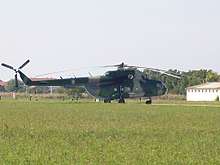
The Yugoslav Air Force took delivery of 24 Mi-8T (Hip C) transport helicopters between May 1968 and May 1969 to equip two squadrons of the newly formed 119th transport regiment from Niš military airport, each squadron with 12 helicopters. Subsequently, from 1973 to the early 1980s, Yugoslavia purchased more Mi-8T helicopters to re-equip two squadrons of 111th regiment from Pleso military airport near Zagreb and the 790th squadron from Divulje military airport near Split, which was under the command of the Yugoslav Navy. In total, the Yugoslav Air Force received 92 Mi-8Ts, designated by the Yugoslav People's Army as the HT-40, while local modification of several helicopters into electronic warfare variants produced the HT-40E. Some 40 helicopters were equipped for firefighting operations.
The Yugoslav Mi-8s' first combat operations were transport of Yugoslav People's Army troops and federal police forces to border crossings in Slovenia on 27 June 1991 during the Ten-Day War. The members of Slovenian Territorial Defence fired Strela 2 MANPAD, and shot one helicopter down, killing all crew and passengers.
During combat in the winter of 1991 in the Croatian war and in the spring of 1992 in the Bosnian War, the Yugoslav People's Army used the Mi-8 fleet for the evacuation of injured personnel, transport of cargo and search and rescue for the crews of aircraft forced down. As most flights were made behind the front, the Croatian forces were able to down just one helicopter, which was hit by small arms fire near Slavonski Brod on 4 October 1991.
After Bosnian Serbs declared their state in the spring of 1992, some former Yugoslav Air Force Mi-8s continued service with the Republika Srpska armed forces. The inventory of the 82nd mixed helicopter squadron, of the 92nd aviation brigade of the Army of Republika Srpska comprised 12 Mi-8T helicopters, which continued in service until Operation Koridor. During that period, the Republika Srpska Air Force lost three Mi-8 helicopters to enemy fire. Three helicopters painted in a blue and white colour scheme flew in the first part of 56th helicopter squadron of the Krajina Milicija, using Udbina military airport in Lika as their main base. The Republika Srpska Air Force continued to operate nine helicopters, albeit suffering problems with maintenance and spare parts, until it was formally disbanded in 2006.
On the other side, Mi-8 helicopters were also used as main air transport. The Croatian National Guard obtained its first on 23 September 1991, near Petrinja, when a Yugoslav Air Force Mi-8 made an emergency landing after being damaged by small-arms fire. A further 6 Mi-8T and 18 Mi-8MTV-1 helicopters were bought from ex-Warsaw Pact countries during the war, but only 16 of those survived the war. The remaining Mi-8Ts were retired from service in the Croatian Air Force after the war, while the Mi-8MTVs continued their service in 20th Transport Helicopter Squadron and 28th Transport Helicopter Squadron. The latter has been re-equipped with new Mi-171Sh helicopters bought from Russia.
The Army of the Republic of Bosnia and Herzegovina secretly obtained Mi-8T, Mi-8MTV and Mi-17 helicopters from various sources. Two helicopters were shot down by Serb air defenses, one around Žepa, while one Mi-17 was shot down by 2K12 Kub M, killing the Bosnian Foreign Affairs Minister Irfan Ljubijankić, a few other politicians, and the helicopter's Ukrainian crew. A few Croatian Mi-8MTVs secretly supported Croatian Defence Council operations in Herceg Bosna. After the war, the Army of the Federation of Bosnia and Herzegovina operated the remaining five Mi-8MTVs and one Mi-8T in the Air Force and Air Defense Brigade of Armed Forces of Bosnia and Herzegovina.
The Macedonian Air Force bought two Mi-8MT helicopters in 2001 from Ukraine. They fly in the Transport Helicopter Squadron (ex 301. Transport Helicopter Squadron). One crashed, killing all 8 passengers and 3 crew members in an accident in January 2008.
During the Kosovo War of 1998 and 1999, the Federal Yugoslav Air Force used Mi-8s for transport of personnel and material to forces in otherwise-inaccessible mountain areas. Evacuation of injured personnel also occurred during the 1999 NATO bombing of Yugoslavia, flying at low altitude to avoid detection by NATO aircraft. In 1999, Yugoslav Mi-8s shot down at least one US Army Hunter UAV with the door gunner's 7.62 mm machine gun.[26][27] Two Mi-17V helicopters secretly operated by the Special Operations Unit post-1997 were also active during the Kosovar conflict. After the unit disbanded in 2003, the helicopters were transferred to Serbia and Montenegro's air force.
As of mid-2020, the Serbian Air Force, the successor of the Federal Yugoslav Air Force, operates a small amount of Mi-8T which are now being replaced by Mi-17 helicopters. There are 13 Mi-17 in the serbian air force currently. They are in the 138th Mixed-Transport-Aviation Squadron of 204th Air Base and 119th Combined-Arms Helicopter Squadron (ex 199th regiment) of 98th Air Base.
Others
During the Yom Kippur War of October 1973, Syria landed special forces troops behind Israel Defense Forces lines on the Golan Heights at Mt. Hermon, Tel Fares, Vaset, Nafach and Ein Zivan – A Dalve.
On 4 December 2003, a Polish Mi-8 crashed near Piaseczno while carrying Prime Minister Leszek Miller, ten other passengers and four crewmen. There were no fatalities. The cause of the accident was the icing of the engines. The pilot was accused of causing the crash, but he was found not guilty.
Variants
Prototypes/experimental/low production rate
- V-8 (NATO – Hip-A)
- The original single-engined prototype.
- V-8A
- A twin-engined prototype, featuring TV2-117 turboshaft engines, the prototype underwent further modifications during its life.
- V-8AT
- Prototype of the Mi-8T utility version.
- Mi-8 (NATO – Hip-B)
- Twin-engined prototype.
- Mi-8TG
- Conversion to operate on LPG gas.
- Mi-18
- Prototype design, a modification of the existing Mil Mi-8. Two Mi-8s were extended by 0.9 meters (3 ft), the landing gear made retractable, and a sliding door added to the starboard side of the fuselage. The Mi-18s were used in the Soviet invasion of Afghanistan, and later used as static training airframes for pilots of the Mi-8/17.
Basic military transport/airframe
- Mi-8T (NATO – Hip-C)
- First mass production utility transport version, it can carry four UV-16-57 unguided rocket pods, (with S-5 rockets), mounted to four hardpoints on two outrigger pylons, and is armed with one or two side-mounted PK machine guns.
- Mi-8TV
- Armed version of the Mi-8T.
- Mi-8TVK (NATO – Hip-E, a.k.a. Mi-8TB)
- Version used as a gunship or direct air support platform. Airframe modifications add 2x external hard points for a total of 6, and mount a flexible 12.7 mm (0.5-inch) KV-4 machine gun in the nose. Armament of 57 mm S-5 rockets, six UV-32-57 rocket pods, 551-lb (250-kg) bombs, or four AT-2 Swatter ATGMs.
- Mi-8TBK (NATO – Hip-F)
- Armed export version, fitted with six launch rails to carry and fire Malyutka missiles.
Command and electronic warfare
- Mi-8IV (NATO – Hip-G, a.k.a. Mi-9)
- Airborne command post version fitted with "Ivolga" system, characterized by antennas, and Doppler radar on tail boom.
- Mi-8PP (NATO – Hip-K)
- Airborne jamming platform with "Polye" (field) system. From 1980, the type was fitted with the new "Akatsiya" system and redesignated the Mi-8PPA. It is characterized by six "X"-shaped antennas on each side of the aft fuselage. Built to escort troop-carrying versions of this helicopter, and disrupt potentially-nearby SPAAG radars, such as those of the Flakpanzer Gepard.
- Mi-8PD
- Polish airborne command post version.
- Mi-8SMV (NATO – Hip-J)
- Airborne jamming platform with "Smalta-V" system, characterized by two small boxes on each side of the fuselage. Used for protection of ground attack aircraft against enemy air defenses.
- Mi-8VPK (NATO – Hip-D, a.k.a. Mi-8VzPU)
- Airborne communications platform with rectangular communication canisters mounted on weapons racks and with two frame-type arials above the rear fuselage.
Other military
- Mi-8AD
- Minelaying version with four VSM-1 dispensers. Each dispenser contains 29 cassettes KSO-1 with anti-personnel mines, for example 7,424 x PFM-1 or 464 x POM-2 or 116 x PTM-3.
- Mi-8AV
- Minelaying version with VMR-1 or −2 system for 64 or 200 anti-tank mines.
- Mi-8BT
- Mine-clearing version.
- Mi-8MB "Bissektrisa"
- Military ambulance version.
- Mi-8R (a.k.a. Mi-8GR)
- Tactical reconnaissance version with Elint system "Grebeshok-5".[28]
- Mi-8K
- Artillery observation, reconnaissance version.
- Mi-8SMT
- Military staff transport version, fitted with improved radio equipment R-832 and R-111.
- Mi-8SKA
- Photo-reconnaissance version.
- Mi-8T(K)
- Photo-reconnaissance version.
- Mi-8TZ
- Fuel transport tanker version.
- Mi-8MTYu
- Only one was built and used by the Ukrainian Air Force, based at AB "Kirovskoe". Intended for detection of re-entry vehicles, and small surface targets. In the nose radar antenna.
- Mi-8MSB
- Modernized passenger-transport version for the civil aviation.[29]
- Mi-8MSB-V
- Modernized multipurpose helicopter for the Ukrainian Armed Forces.[30]
Civil
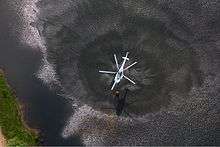
- Mi-8T (NATO – Hip-C)
- Civilian and military utility transport version, with accommodation for 24 passengers, fitted with tip-up seats along the cabin walls, circular cabin windows and large rear clamshell doors with a sloping hinge line. The Mi-8T is powered by two 1,677 shp (1,251 kW) Klimov TV2-117A turboshaft engines, giving the helicopter a maximum speed of 155 mph (249 km/h) at sea level.
- Mi-8P
- Civilian passenger transport version, with accommodation for between 28 and 32 passengers, fitted with square cabin windows, small rear clamshell doors with a vertical hinge line and a horizontally split rear airstair door in between; powered by two 1,700 hp (1,300 kW) Klimov TV2-117A turboshaft engines.
- Mi-8S "Salon"
- Civilian VIP transport version, with accommodation for between 9 and 11 passengers, equipped with a galley and toilet.
- Mi-8MPS
- Search and rescue version (operated usually in Malaysia for Fire and Rescue Department services).
- Mi-8MA
- Polar exploration version for use in the Arctic.
- Mi-8MT
- Flying crane version.
- Mi-8AT
- Civilian transport version, fitted with two improved TV2-117AG turboshaft engines.
- Mi-8ATS
- Agricultural version, fitted with a hopper and spray bars.
- Mi-8TL
- Air accident investigation version.
- Mi-8TM
- Upgraded transport version, fitted with a weather radar.
- Mi-8TS
- Hot and high desert version.
- Mi-8VIP
- Deluxe VIP transport version, with accommodation for between 7 and 9 passengers.
- Mi-8PA
- Modified version for Japanese regulations. One only was built, in 1980. It was used by Aero Asahi for heavy material transport in a mountainous region. It was retired in 1993 and later moved to the Tokorozawa Aviation Museum.
Operators



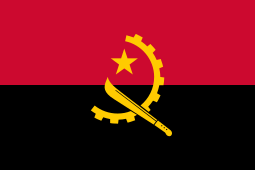









.svg.png)














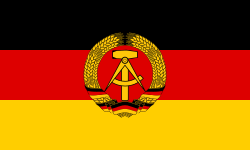








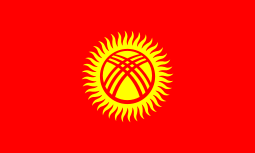

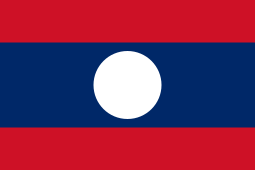







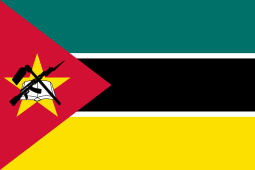








%3B_Flag_of_Serbia_and_Montenegro_(2003%E2%80%932006).svg.png)



.svg.png)





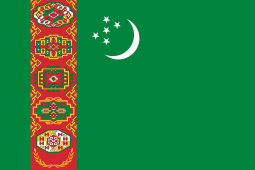






.svg.png)
Former operators
Gallery
_(14225949458).jpg) Russian Air Force Mil Mi-8AMTSh
Russian Air Force Mil Mi-8AMTSh- Indian Air Force Mil Mi-8
- Polish Air Force Mil Mi-8
 Lithuanian Air Force SAR Mil Mi-8T
Lithuanian Air Force SAR Mil Mi-8T Royal Lao Air Force Mil Mi-8
Royal Lao Air Force Mil Mi-8
Specifications (Mi-8MT)
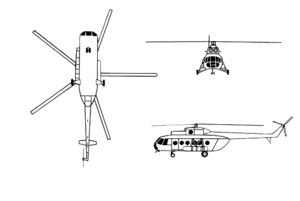
Data from Jane's All The World's Aircraft 1992–93[48]
General characteristics
- Crew: 3 (pilot, copilot, flight engineer)
- Capacity: 24 passengers or 12 stretchers and seat for 1 medical attendant or 4,000 kg (8,800 lb) on internal/external hardpoints
- Length: 18.4 m (60 ft 4 in)
- Height: 5.5 m (18 ft 1 in)
- Empty weight: 7,100 kg (15,653 lb)
- Gross weight: 11,100 kg (24,471 lb)
- Max takeoff weight: 13,000 kg (28,660 lb)
- Fuel capacity: 3,700 l (980 US gal; 810 imp gal)
- Powerplant: 2 × Klimov TV3-117MT turboshaft engines, 1,454 kW (1,950 hp) each
- Main rotor diameter: 21.29 m (69 ft 10 in)
- Main rotor area: 356 m2 (3,830 sq ft)
- Blade section: NACA 23012[49]
Performance
- Maximum speed: 250 km/h (160 mph, 130 kn)
- Cruise speed: 240 km/h (150 mph, 130 kn)
- Range: 495 km (308 mi, 267 nmi)
- Ferry range: 960 km (600 mi, 520 nmi)
- Service ceiling: 5,000 m (16,000 ft)
Armament
- 4,000 kg (8,818 lb) of disposable stores on six hardpoints, including 57 mm S-5 rockets, bombs, or 9M17 Phalanga ATGMs and one or two side-mounted PK machine guns
See also
Related development
Aircraft of comparable role, configuration and era
References
- John Pike. "Mi-8 HIP (MIL)". Globalsecurity.org. Archived from the original on 20 December 2014. Retrieved 24 December 2014.
- "Strength in numbers: The World's Top 10 military aircraft types". Flightglobal.com. Reed Business Information Limited. 9 January 2015. Archived from the original on 17 November 2015. Retrieved 30 October 2015.
- Mi-8 Helicopter. Development History. mi-helicopter.ru
- Donald, David, ed. "Mil Mi-8". The Complete Encyclopedia of World Aircraft. Barnes & Noble Books, 1997. ISBN 0-7607-0592-5.
- Frawley, Gerald (2002). "Mil Mi-8 & Mi-17". The International Directory of Military Aircraft, 2002/2003. Fishwick, Act: Aerospace Publications. ISBN 1-875671-55-2.
- "Mil Mi-8 – NATO code: HIP". Army.cz. Archived from the original on 14 July 2014. Retrieved 24 December 2014.
- Karsten Palt. "Mil Mi-8". Flugzeuginfo.net. Archived from the original on 25 December 2014. Retrieved 24 December 2014.
- Jane's All The World's Aircraft. 1975–1976. p. 502. ISBN 0-354-00521-9.
- Sikorsky, Sergei I. "The Sikorsky Legacy". Arcadia Publishing, 2007. ISBN 978-0-7385-4995-8.
- "Mil Mi-8". Wiki.scramble.nl. Archived from the original on 25 December 2014. Retrieved 24 December 2014.
- "YouTube". YouTube. Archived from the original on 21 March 2016. Retrieved 24 December 2014.
- "CIS region – Авиация в локальных конфликтах". Skywar.ru. Archived from the original on 19 April 2018. Retrieved 24 April 2018.
- "Special Report : World Air Forces" (PDF). Img.en25.com. 2014. Archived (PDF) from the original on 7 January 2016. Retrieved 24 April 2018.
- Pike, John. "AH-1W Air Combat Maneuver Training – Why It Must Be Reinstated". Globalsecurity.org. Archived from the original on 12 June 2018. Retrieved 24 April 2018.
- "BBC News – South Sudan army 'shoots down UN helicopter'". BBC News. Archived from the original on 2 May 2015. Retrieved 24 December 2014.
- "UN helicopter shot down in South Sudan". aljazeera.com. Archived from the original on 23 December 2012. Retrieved 22 December 2012.
- "Russian airline says its helicopter likely shot down in South Sudan". Reuters. Archived from the original on 25 December 2014. Retrieved 24 December 2014.
- "Three killed in UN helicopter crash in South Sudan after rebel warning". the Guardian. Archived from the original on 25 December 2014. Retrieved 24 December 2014.
- Simon, Michael. (28 June 2010) Chernobyl’s Radioactive Scrapyard Archived 9 February 2017 at the Wayback Machine. RecycleNation. Retrieved on 18 May 2016.
- Mil Mi-8 crash near Chernobyl on YouTube 2006.
- "Special Report: 1997: Chernobyl: Containing Chernobyl?". BBC News. 21 November 1997. Archived from the original on 19 March 2011. Retrieved 20 August 2011.
- Modernized Mi-8MSB helicopter sets world altitude record, Interfax-Ukraine (16 August 2013)
- "Ukrainian Mi-8 shot down near Slavyansk". Janes.com. Archived from the original on 25 December 2014. Retrieved 24 December 2014.
- "BBC News – Ukraine army helicopter shot down despite ceasefire". BBC News. Archived from the original on 16 February 2015. Retrieved 24 December 2014.
- Central Intelligence Agency#Osama bin Laden
- "European Air-to-Air Victories". Acig.org. Archived from the original on 23 October 2014. Retrieved 24 December 2014.
- Military Mi-8 HIP helicopter to fly alongside a Hunter UAV and then have the Door Gunner blast the UAV with his 7.62mm machine gun Archived 8 April 2013 at the Wayback Machine. None. Retrieved on 18 May 2016.
- "Mi-8R". 16va.be. Archived from the original on 25 December 2014. Retrieved 24 December 2014.
- Karpenko, A.V. "The modernized Mi-8MSB (Ukraine)". Bastion-karpenko.ru. Archived from the original on 3 October 2016. Retrieved 3 October 2016.
- "Motor Sich proposes Ukrainian Mi-8 MSB-V upgrades, new variants | IHS Jane's 360". Janes.com. Archived from the original on 3 October 2016. Retrieved 3 October 2016.
- "World Air Forces 2013" (PDF). Flightglobal Insight. 2013. Archived from the original (PDF) on 16 December 2012. Retrieved 20 March 2013.
- "Albanian Defense Ministry". Aaf.mil.al. Archived from the original on 3 April 2015. Retrieved 10 July 2014.
- "Ceskoslovenske VoJenske Letectvo Mi-17". Helis.com. Archived from the original on 26 May 2013. Retrieved 20 March 2013.
- "Mi-8 Medium Utility Helicopter". Flugzeuginfo.net. Archived from the original on 11 March 2013. Retrieved 20 March 2013.
- "World's Air Forces 1987". p. 50. Archived from the original on 17 May 2013. Retrieved 20 March 2013.
- "World's Air Forces 1987". Flightglobal.com. p. 59. Archived from the original on 17 December 2014. Retrieved 20 March 2013.
- "GM Helicopters fleet". Gmhelicopters.com. Archived from the original on 1 February 2014. Retrieved 20 March 2013.
- "World's Air Forces 1987". Flightglobal.com. p. 80. Archived from the original on 17 May 2013. Retrieved 20 March 2013.
- "World's Air Forces 2004". Flightglobal.com. p. 84. Archived from the original on 17 May 2013. Retrieved 20 March 2013.
- "World's Air Forces 1987". p. 86. Archived from the original on 17 May 2013. Retrieved 20 March 2013.
- "World's Air Forces 2004". Flightglobal.com. p. 46. Archived from the original on 14 January 2015. Retrieved 20 March 2013.
- MilAvia Press. "Order of Battle – Transnistria". Milaviapress.com. Archived from the original on 17 October 2017. Retrieved 7 August 2017.
- valerys (18 August 2007). "Tiraspol Flughafen". Panoramio.com. Archived from the original on 17 October 2017. Retrieved 7 August 2017.
- "Turk Jandarma Teskilati Mi-8/17". Helis.com. Archived from the original on 25 May 2013. Retrieved 20 March 2013.
- "Army gets two more Russian helicopters". Huntsville times.com. 23 December 2011. Archived from the original on 30 March 2013. Retrieved 20 March 2013.
- "World's Air Forces 1987". p. 67. Archived from the original on 15 July 2015. Retrieved 20 March 2013.
- "Trade Registers". SIPRI. Retrieved 27 January 2020.
- Lambert, Mark; Munson, Kenneth; Taylor, Michael J.H., eds. (1992). Jane's all the world's aircraft 1992–93 (83rd ed.). Coulson, Surrey, UK: Jane's Information Group. ISBN 978-0710609878.
- Lednicer, David. "The Incomplete Guide to Airfoil Usage". m-selig.ae.illinois.edu. Retrieved 16 April 2019.
The initial version of this article was based on material from aviation.ru. It has been released under the GFDL by the copyright holder.
External links
| Wikimedia Commons has media related to Mil Mi-8. |